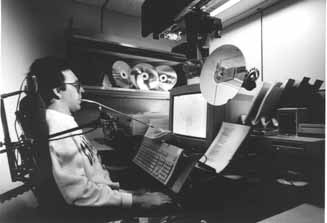1996 Project Reports | Home |
Contents | Previous |
Next |
Vocational Training Facility - an interactive, accessible system for skill
development
Inder Perkash, MD; Charles Burgar, MD; H. F. Machiel Van der Loos, PhD; Joy
Hammel, PhD; Dan Shafer, OTR; Eric Topp, MS; Deane F. Denney; Pam LePage, MEd;
David Lees, MS
Objectives - The goal of the Vocational Training Facility (VTF)
Project was to develop and test a novel curriculum concept to teach desktop
publishing skills to students with high-level quadriplegia in preparation for
return to employment. These skills were taught in a workstation setting, using
adaptive access equipment and devices, including a voice-controlled robot for
manipulation assistance.
Research Plan - The VTF Project included the implementation of three
robot-equipped workstations. Each workstation provided multimedia presentation
of curriculum materials to teach skills for entry-level positions in desktop
publishing and presentation. Videodisc materials supplemented instructional
software to provide an accessible, integrated learning environment. Four-month
training sessions accommodated three students at a time. Sixteen students were
tested in total. In addition to conventional batteries of test instruments,
software records of computer usage and robot actions have permitted subsequent
analysis of the effectiveness of the VTF concept.
Methodology - The workstations were equipped with a variety of
interface devices for individualized access by students with quadriplegia. In
addition, the robot was able to perform all needed daily-living (e.g., lunch,
beverages, medication) and vocational support (e.g., printer output,
mouthstick, phone) tasks while the student was at the workstation. With these
supports, as well as the multimedia curriculum design, each student was able to
perform self-paced learning of vocational skills. The VTF Project tested this
approach in a study including high-level and low-level quadriplegic veterans as
well as a control group of paraplegic students.
Results - In the first 18 months, the VTF Project completed the
procurement process for hardware, software, and training materials; configured
and programmed three robot workstations for the set of VTF equipment; contacted
local companies for Task Force involvement and internship placement; wrote the
core instructional software necessary for the curriculum; completed the editing
and pressing of three DTP videodiscs; and prepared materials for and worked
with the VA Spinal Cord Injury Service and the California State Department of
Rehabilitation to identify prospective disabled veterans.
 Figure 1. This
student with high level quadriplegia commands DEVAR, the robot assistant, to
insert an instructional videodisc. The VTF project produced three videodiscs
covering areas such as desktop publishing, robot use, and job skills, as part
of the curriculum.
In the remaining 24 months, a total of 16 students were recruited. The
outcome "success" of the project was defined as the ability to
participate in the 12-week course, complete an internship, and pursue a job
opportunity. Of the 16, two did not complete the course due to medical reasons.
Seven completed one or more internships. Currently, seven of the 16 are engaged
in follow-on education or gainful employment (either following the internship
phase or directly after the VTF training), while six are actively pursuing
educational, internship or job opportunities.
|
Rehab R&D Center VTF staff, in conjunction with DPI Inc. in San Jose,
CA, co-authored and subsequently received an SBIR Phase I research grant from
the Department of Education. Under the directive of this grant, we worked with
DPI to assess the feasibility of tech transfer and curriculum retooling to
provide training to individuals with disabilities other than SCI. We are
awaiting the results of the SBIR Phase II submission which detailed a two-year
plan involving substantial curriculum modification and a revamping of the
original VTF interactive desktop publishing Hypercard tutorial.
Republished from the 1996 Rehabilitation R&D Center Progress Report. For
current information about this project, contact:
H. F. Machiel Van der Loos.

